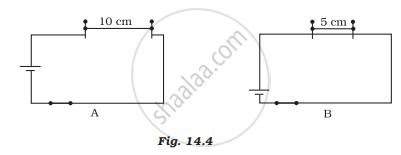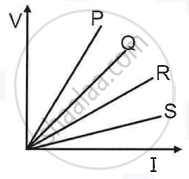Advertisements
Advertisements
प्रश्न
Paheli took a wire of length of 10 cm. Boojho took a wire of 5 cm of the same material and thickness. Both of them connected the wires as shown in the circuit given in Figure 14.4. The current flowing in both circuits is the same.
(i) Will the heat produced in both cases be equal? Explain
(ii) Will the heat produced be the same if the wires taken by them are of equal lengths but of different thicknesses? Explain.

उत्तर
(i) No, the amount of heat produced in both cases will not be equal. The amount of heat produced in a wire depends upon the length of the wire.
(ii) No, the amount of heat produced in the wire depends upon the thickness of the wire.
APPEARS IN
संबंधित प्रश्न
Give a scientific reason.
For electric power transmission, copper or aluminium wire is used.
Give Scientific reason.
In practice, the unit kWh is used for the measurement of electrical energy, rather than joule.
Write two devices based on the heating effect of electric current.
Which of the following is correct?
A fuse wire repeatedly gets burnt when used with a good heater. It is advised to use a fuse wire of:
The heating element of an electric iron is made up of:
When a switch is in the OFF position,
(i) circuit starting from the positive terminal of the cell stops at the switch.
(ii) circuit is open.
(iii) no current flows through it.
(iv) current flows after some time. Choose the combination of the correct answers from the following.
An electric fuse has a body made of ceramic and two points for connecting the fuse wire.
Explain the working of an electric fuse.
The graph of voltage vs current for four different materials is shown below.

Which of these four materials would be used for making filament of bulb?
